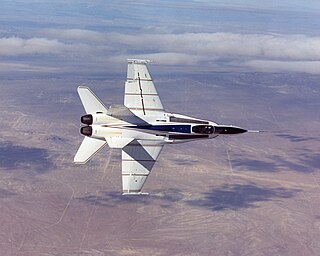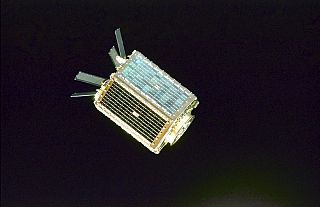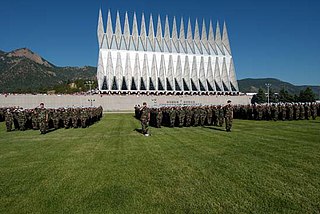
The Lincoln Near-Earth Asteroid Research (LINEAR) project is a collaboration of the United States Air Force, NASA, and the Massachusetts Institute of Technology's Lincoln Laboratory for the systematic detection and tracking of near-Earth objects. LINEAR was responsible for the majority of asteroid discoveries from 1998 until it was overtaken by the Catalina Sky Survey in 2005. As of 15 September 2011, LINEAR had detected 231,082 new small Solar System bodies, of which at least 2,423 were near-Earth asteroids and 279 were comets. The instruments used by the LINEAR program are located at Lincoln Laboratory's Experimental Test Site (ETS) on the White Sands Missile Range (WSMR) near Socorro, New Mexico.

Richard Harrison Truly is a retired vice admiral in the United States Navy, a former fighter pilot, engineer, astronaut, and was the eighth administrator of the National Aeronautics and Space Administration (NASA) from 1989 to 1992. He was the first former astronaut to head the space agency.

The MIT Lincoln Laboratory, located in Lexington, Massachusetts, is a United States Department of Defense federally funded research and development center chartered to apply advanced technology to problems of national security. Research and development activities focus on long-term technology development as well as rapid system prototyping and demonstration. Its core competencies are in sensors, integrated sensing, signal processing for information extraction, decision-making support, and communications. These efforts are aligned within ten mission areas. The laboratory also maintains several field sites around the world.

The Air Force Research Laboratory (AFRL) is a scientific research and development detachment of the United States Air Force Materiel Command dedicated to leading the discovery, development, and integration of direct-energy based aerospace warfighting technologies, planning and executing the Air Force science and technology program, and providing warfighting capabilities to United States air, space, and cyberspace forces. It controls the entire Air Force science and technology research budget which was $2.4 billion in 2006.

Rome Laboratory is the US "Air Force 'superlab' for command, control, and communications" research and development and is responsible for planning and executing the USAF science and technology program.
Doug Beason is an American scientist and science fiction author.
Pioneer Rocketplane was an aerospace design and development company intent on developing affordable crewed space flight. The company is most famous for advocating a horizontal takeoff, turbo-jet and rocket propelled, aerial-refueled, rocket plane concept called the Pathfinder. The company still exists, but is no longer in operation. Pioneer's intellectual property is now owned by Rocketplane Limited, Inc., however Rocketplane Limited does not employ any of the principals of Pioneer Rocketplane.
The PFF National Challenge Cup is an annual knockout football competition in men's domestic Pakistani football within the Pakistan football league system. It is organized by and named after the Pakistan Football Federation.

The X-53 Active Aeroelastic Wing (AAW) development program is a completed American research project that was undertaken jointly by the Air Force Research Laboratory (AFRL), Boeing Phantom Works and NASA's Dryden Flight Research Center, where the technology was flight tested on a modified McDonnell Douglas F/A-18 Hornet. Active Aeroelastic Wing Technology is a technology that integrates wing aerodynamics, controls, and structure to harness and control wing aeroelastic twist at high speeds and dynamic pressures. By using multiple leading and trailing edge controls like "aerodynamic tabs", subtle amounts of aeroelastic twist can be controlled to provide large amounts of wing control power, while minimizing maneuver air loads at high wing strain conditions or aerodynamic drag at low wing strain conditions. This program was the first full-scale proof of AAW technology.

MightySat-1 was a small spacecraft developed by the U.S. Air Force's Phillips Laboratory to test technology for small satellites, including advanced dual-junction solar cells, a composite structure, a micrometeorite and debris detector, low-power electronics and a low-shock release device. The 140-pound satellite was launched from the Space Shuttle Endeavour in December 1998, during the 12th day of the STS-88 mission and performed robustly in orbit, with no spacecraft anomalies during its mission. Lt. Barbara Braun of the AFRL was the program manager for the satellite.

Technology for Autonomous Operational Survivability was a satellite developed by the US Air Force's Phillips Laboratory to test technology for autonomous operation of spacecraft.

The United States Air Force Academy, Cadet Area is a portion of the United States Air Force Academy near Colorado Springs, Colorado. Its use of modern architecture stands in contrast with the very traditional designs of West Point and the United States Naval Academy. It was designated a National Historic Landmark District in 2004 for its landscape, architecture, and historic importance as a military academy.

Brunswick Air Force Station is a closed United States Air Force General Surveillance Radar station. It is located 2.5 miles (4.0 km) east-southeast of Brunswick, Maine. It was closed in 1965.

Kingman Air Force Station is a closed United States Air Force General Surveillance Radar station. It is located 1 mile (1.6 km) southwest of Kingman, Arizona. It was closed in 1958.
The 503d Aircraft Control and Warning Group (AC&WG) is an inactive United States Air Force unit. Its last assignment was with Air Defense Command (ADC)'s 26th Air Division at Roslyn AFS New York. It was inactivated in 1952.
The 540th Aircraft Control and Warning Group is an inactive United States Air Force unit. It was assigned to the 32d Air Division, stationed at Stewart Air Force Base, New York. It was inactivated on 6 February 1952.
The 545th Aircraft Control and Warning Group is an inactive United States Air Force unit. It was assigned to the 29th Air Division, stationed at Great Falls Air Force Base, Montana. It was inactivated on 6 February 1952.
The 544th Aircraft Control and Warning Group is an inactive United States Air Force unit. It was assigned to the 27th Air Division, and last stationed at Norton Air Force Base, California. It was inactivated on 6 February 1952.
Miniature Sensor Technology Integration-3 (MSTI-3) was a technology demonstration satellite operated by the United States Air Force. It was equipped with two infrared cameras and one visible light camera, designed to survey Earth's surface features and characterize their appearance in infrared wavelengths. MSTI-3 launched on 17 May 1996 aboard an Orbital Sciences Pegasus rocket.
The Guenter Loeser Memorial Award was first established in 1955 at the Air Force Cambridge Research Laboratory. It was named after Dr. Loeser, a meteorologist who lost his life while conducting a field experiment. Over time, AFCRL became the Air Force Geophysics Laboratory at Hanscom Air Force Base and has now become the Air Force Research Laboratory Space Vehicles Directorate Battlespace Environment Laboratory, AFRL/RVB, at Kirtland Air Force Base.










